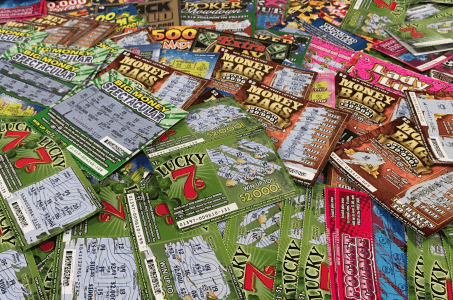Las Vegas Ride-Hailing Services Face ‘Severe’ Driver Shortage, Lyft Worker Blames Pay
Posted on: April 13, 2021, 04:06h.
Last updated on: April 13, 2021, 09:12h.
Las Vegas passengers continue to complain about lengthy delays when waiting for Lyft or Uber rides at casinos or McCarran Airport. But drivers for these ride-hailing services respond they are not earning enough money to make it worthwhile.

One Lyft driver, Jane, revealed recently on Casino.org, “I’m sick of it. Too much work for too little pay, and waaaay too much attitude from people. I’m over it.”
Las Vegas is among the US cities where there are “severe” shortages of ride-hailing services, the Financial Times reported last week. Several drivers say it is due to the pay.
Lyft keeps paying less,” Jane said in her post. “It’s confusing to me, because drivers pay 100% of gas, car washes, and maintenance, not to mention extra insurance for being rideshare drivers.”
“What expenses does Lyft have?? But they take over 50% of every ride.”
There are now fewer drivers working for the company. “And customers are piling up,” she said. “You would think Lyft would get a clue and fix the issue by giving meaningful bonuses and incentives.”
Jane also reveals fewer than 10 percent of her passengers pay any tip.
“We drive for FREE to pick you up, and lots of times people take the 5 full minutes to come outside, with an attitude, demanding to know why it took so long to get a ride,” Jane says. “Eventually people are just going to have to resort back to getting completely ripped off by taxis again.”
Another Lyft driver, Barry, told Casino.org, “I have been through 5 paycuts, and 3 rental increases. I’m out driving 6 days a week and do a minimum of 100 … rides a week.”
Lyft pays him 15 cents a minute and 39 cents a mile.
“Most times I receive about 40% of what the ride costs you,” Barry said. “Take the time to realize we are REAL people just like you trying to take care of our families.”
Driver Incentives from Uber, Lyft
To help remedy the situation, nationally Uber and Lyft say they are taking some steps. For instance, Uber will spend $250 million on driver incentives.
Lyft will pay for rental cars, as well as provide bonuses of up to $800 for referring ex-drivers to the ride-hailing service, the Financial Times adds.
Lyft will also pay extra when the drive to reach a passenger takes longer than nine minutes, the Financial Times said.
There are several reasons for the driver shortage, with many related to the coronavirus outbreak. For instance, the amount paid in unemployment checks discourages former drivers from resuming work. Many former drivers also are avoiding driving passengers because they are worried about COVID-19 risk.
Since the pandemic, some drivers opted to take jobs delivering food and groceries, the Financial Times quoted Jefferies analyst Brent Thill.
This is confirmed by a former driver, Jay, on Casino.org. He says he earns “more money” for Doordash than he would “driving people around.”
In fact, the number of active ride-hailing drivers in Nevada is less than half of what it was a year ago, according to the Las Vegas Review-Journal. As of March 30, there were 13,723 active ride-hailing drivers in Nevada. That compares to 36,482 on March 13, 2020.
Demand for Ride-Hailing Services Edges Up
But in recent weeks, demand for ride-hailing nationally has increased.
“As of the week of March 29, 2021, Uber … regained 53 percent of the ground lost in the big drop of spring 2020. Lyft had regained 51 percent,” Edison Trends reported. Las Vegas has also seen an upturn in visitor volume leading to more need for rides.
We want drivers to take advantage of higher earnings now because this is likely a temporary situation. As the recovery continues, we expect more drivers will be hitting the road, which means that over time, earnings will come back to pre-COVID levels,” Dennis Cinelli, Uber vice president, US & Canada Mobility, said in the company blog.
Ride-hailing services also want drivers to be able to use surge pricing. Under such an approach, when there is very high demand, prices may increase. But Nevada regulators prohibit surge pricing during a health emergency.
Related News Articles
Most Popular
Genovese Capo Sentenced for Illegal Gambling on Long Island
NBA Referees Expose Sports Betting Abuse Following Steve Kerr Meltdown
UPDATE: Former Resorts World & MGM Grand Prez Loses Gaming License
VEGAS MYTHS RE-BUSTED: The Traveling Welcome to Las Vegas Sign
Most Commented
-
UPDATE: Whiskey Pete’s Casino Near Las Vegas Closes
— December 20, 2024 — 33 Comments -
Caesars Virginia in Danville Now Accepting Hotel Room Reservations
— November 27, 2024 — 9 Comments -
UPDATE: Former Resorts World & MGM Grand Prez Loses Gaming License
— December 19, 2024 — 8 Comments -
FTC: Casino Resort Fees Must Be Included in Upfront Hotel Rates
— December 17, 2024 — 7 Comments
















Last Comments ( 3 )
what stopped me from this driving job is the mandatory requirement for state business license and county business license, over $200 annually. i don't OWN & operate these transport businesses, why do i need 2 business licenses ? do i have to pay "business income tax"? if I'm a part owner of uber and Lyft then I'll be glad to pay for the business licenses !! the government need to stop gouging average working people !! Every driver should stop driving untill the business licenses requirement is removed.. how come I don't need business licenses to drive for other transport companies ??
its very simple, tell lyft and uber to fack off, let them go bye bye.
There isn’t no damn pandemic these hotels are full. I had a Uber premier ride the other day and they charged the passenger $38 dollars and I made 11 that was more than 50% Uber kept. If they want drivers put the pay back too 2016 when they first came to Las Vegas. X rides got 1.70 a mile XL was 2.65 a mile Lux 3.10 a mile Black 3.50 mile Black XL 4.25 mile People took them because they didn’t want a stinky TAXI